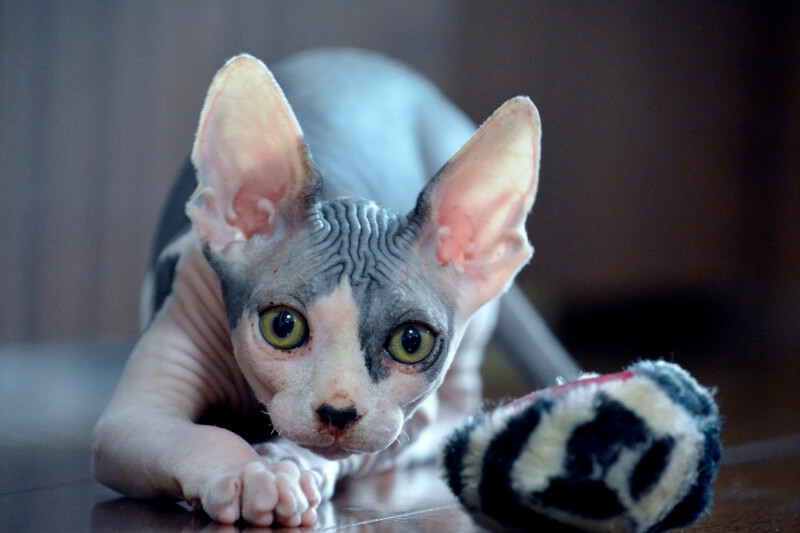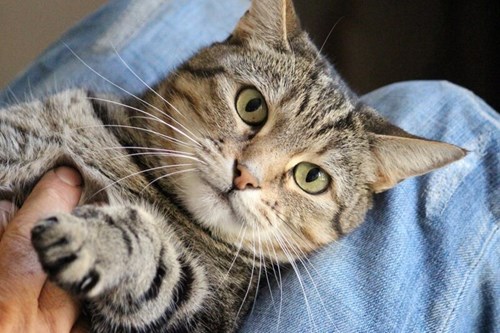
When you picture a Sphynx cat, Mr. Bigglesworth may come to mind – you know, Dr. Evil’s sinister sidekick from the popular Austin Powers movies. However, if you’ve met a Sphynx, you know that these hairless extroverts are anything but evil. In fact, Sphynx cats are irresistibly friendly, affectionate, and curious.
The Skinny on Sphynx Cats
Originally called Canadian Hairless, Sphynx cats are the only cat breed to originate in Canada. They are medium-sized, weighing 6 to 12 pounds, with an average lifespan of 8 to 14 years. Energetic and loyal, Sphynx cats are sometimes described as dog-like. Of course, one of the most remarkable aspects of a Sphynx is their smooth, hairless appearance. In reality, they are covered in very fine fur that makes them feel like warm suede.
Are Sphynx Cats Hypoallergenic?
Some people assume that Sphynx cats are hypoallergenic because they don’t have fluffy coats like their buddies from other breeds. However, cat allergies are actually caused by a protein called Fel d1, which can be found on your kitty’s skin and in their saliva. So while your Sphynx pal’s lack of fur results in less shedding, it doesn't necessarily mean less sneezing.

Origin & History
Although there are early accounts of furless felines in locations as disparate as New Mexico and Paris, the breed as we know it today originated in Toronto, Canada, in the 1960s – completely by accident!
In 1966, a Domestic Shorthair named Elizabeth gave birth to a hairless kitten named Prune, who was immediately recognized as special for this genetic mutation. Prune was adopted by Yania and Riyadh Bawa, a mother-son team that collaborated with experienced breeders Kees and Rita Tenhove to develop the Sphynx breed.
In the mid-70s, Sphynx cats took off in popularity with the growth of the breed traced mainly to these five felines: Dermis and Epidermis, from Wadena, Minn., and Bambi, Punkie, and Paloma, also from Toronto. Over the years, Sphynxes have been crossed with Siamese and Devon Rex cats to keep the breed healthy.
Attributes
At a glance, Sphynx kitties appear to be bald, wrinkly, and pot-bellied. However, despite their round bellies and saggy skin, these loveable cats have broad chests, muscular legs, and impressive jumping skills. Sphynxes have wedge-shaped heads and large, lemon-shaped eyes, giving them a curious expression that matches their high intellect.
Just because they lack a coat doesn’t mean they lack variety. These kitties still exhibit all the glorious color and pattern variations that other breeds do, including:
- White
- Black
- Red
- Chocolate
- Lavender
- Tabby
- Tortoiseshell
- Calico
- Pointed
- Mink
Speaking of hair, Sphynx cats do have a very fine layer covering their bodies with downy tufts near their ears, toes, and nose. They also have thicker than average paw pads and a whip-like tail.
Sphynx Cat Personality
You’ll be hard-pressed to find a friendlier cat than a Sphynx. They get along well with children and other pet pals – including pups – and even make great therapy cats because they don’t mind being handled. They excitedly greet their owners at the door and are welcoming when strangers stop by.
Sphynx cats love attention and will go to great lengths for a laugh. You may want to stock up on puzzle and teaser toys to help keep your pal entertained.

Grooming & Care
Just because your Sphynx kitty doesn’t have a coat doesn’t mean they won’t need regular grooming. Without hair to absorb their natural oils, Sphynx cats can develop an oily film on their skin that leaves residue on your clothing and furniture.
Try to bathe your furless friend weekly, taking extra care to clean in between their endearing skin wrinkles. A Sphynx’s lack of fur also affects their ears, giving your kitty one less defense against dirt and impurities. Clean your pal’s ears weekly, wiping them with a warm, damp cloth or cotton ball. It’s a good idea to contact your veterinarian if you notice any odor or redness. Regular dental care and nail trimming is also a plus.
Special Sphynx Cat Care Tips
Because Sphynx cats are athletic and curious, they sometimes get into dangerous situations by jumping onto high shelves with breakable objects, or you could even find your pal swinging on a door. You may want to invest in a cat tree so that your frisky friend can stay active without causing trouble.
With no coat, your Sphynx has a harder time conserving heat than most kitties. When temperatures drop, try dressing your hairless cutie in a sweater or jacket. It’s functional and completely adorable – win, win! For the same reason, Sphynx cats are big on snuggling, especially when sleeping. If you can, adopt Sphynxes in pairs or let your buddy share your bed.
A lack of hair also makes Sphynx cats susceptible to sunburn and skin cancers, which gives you even more reason to follow the recommendation of our strategic partner the American Society for the Prevention of Cruelty to Animals® (ASPCA®), and always keep your kitty indoors.

Common Health Issues
Overall, Sphynx cats are healthy and robust. In fact, they have a very high metabolism and need to eat more than most cats. Speak with your veterinarian if you have any questions about the appropriate Sphynx diet.
It’s also important to know that the breed does have a high rate of heart disease, including mitral valve dysplasia and heterotrophic cardiomyopathy. Their hairlessness can cause a few health concerns as well, such as respiratory infections (especially in kittens) and skin disorders like urticaria pigmentosa (which results in crusty sores.)
Fun Facts About Sphynx Cats
While a Sphynx cat’s smooth skin is their most obvious attribute, there is so much to love about the breed. Check out these fascinating tidbits:
- Not surprisingly, Sphynx cats were named after the famous statue in Egypt. Early enthusiasts thought the naked kitty skin looked like the limestone that had been worn smooth from thousands of years of wind and sand erosion.
- Donskoys are very similar hairless kitties native to Russia. However, the Sphynx is unique because their baldness comes from a recessive rather than dominant gene.
- A Sphynx cat’s normal body temperature runs about four degrees warmer than other kitties.
- The Journal of Veterinary Behavior ranked Sphynx cats as the most affectionate cat breed.
- Perhaps Sphynx cats have a hidden musical gift because big-time recording artists like Steven Tyler, Lady Gaga, and Demi Lovato are all pet parents to sweet Sphynx kitties.

Name Suggestions
Thinking of adopting one of these wrinkly kitties? You’re sure to want a name that matches their unique appearance and bubbly personality. You could name yours after any of the remarkable kitties who helped get the breed going: Prune, Dermis, Epidermis, Bambi, Punkie, and Paloma. Or, you could draw from Egyptian inspiration with names like:
- Cairo
- Aswan
- Giza
- Horus
- Thoth
If you have a sense of humor half as good as your Sphynx, you may also consider a celebrity namesake who happens to be bald:
- Patrick Stewart
- Bruce Willis
- Vin Diesel
- Seth Godin
When adopting a kitty, it’s also a good idea to look into pet health insurance. Get a quote today!
(opens new window)
Helpful resources for pet parents
Browse categories
-

Do You Know These Historical Dogs and Cats?
Dogs and cats have become famous throughout history and many were recognized for bravery. How many have you heard about?
-

What You Need to Know About Pets and Vaccinations
Get answers to your questions on pets and vaccinations.
-

Cat Urinary Tract Infections (UTIs): Symptoms and Treatment
Is your cat making frequent trips to the litter box? Then a urinary tract problem could be to blame.

Browse Categories
(opens new window)
